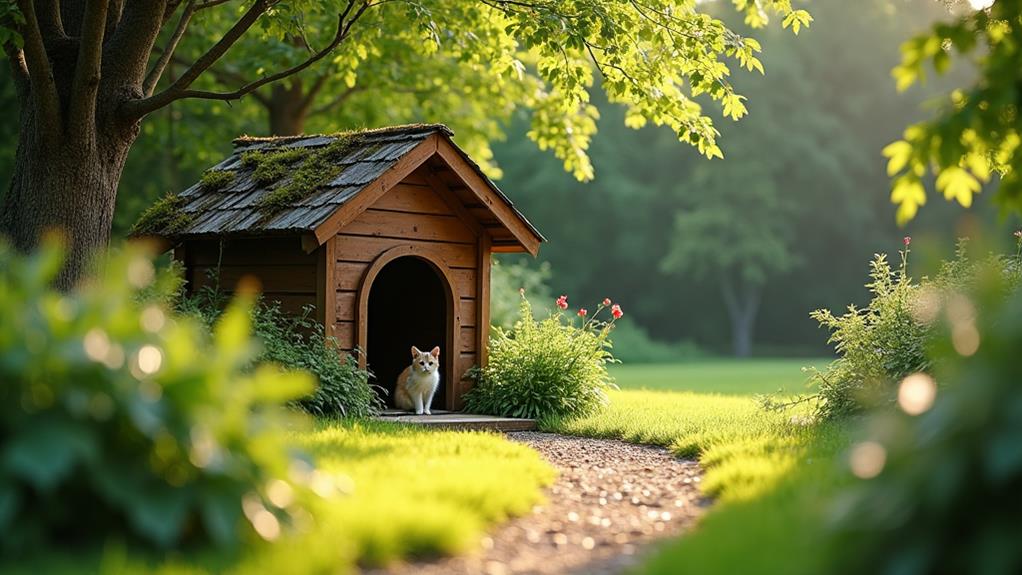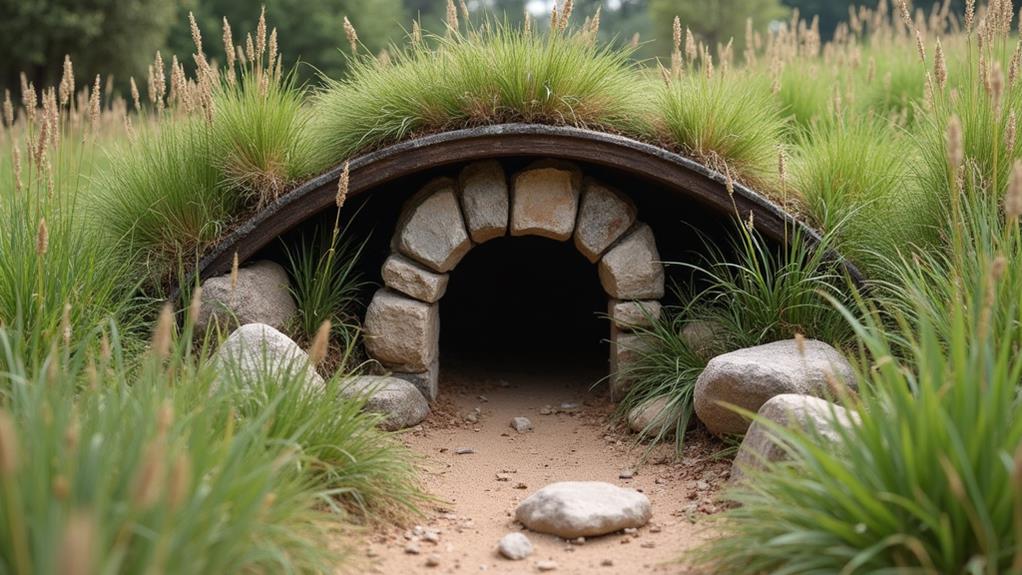Where to Place a Feral Cat Shelter: Tips for Location and Setup

Place your feral cat shelter in a quiet, low-traffic area away from busy roads to reduce stress and accidents. Position it near feeding spots for convenience and safety. Use natural cover like bushes or trees to shield against weather and predators. Raise the shelter 4-6 inches to prevent flooding and face the entrance away from winds and rain. Verify your shelter has small entrances and proper ventilation for heat retention and moisture prevention. Strategically position it to catch morning sunlight and nearby feeding stations for easy access to food and water. Explore deeper to uncover more secrets for a perfect setup.
Selecting the Right Location
When setting up a feral cat shelter, one should focus on choosing the right location to guarantee the cats' comfort and safety. Start by selecting a quiet, secluded area away from busy roads. This minimizes stress and reduces the risk of accidents for feral cats. Ideally, position the shelter near existing feeding spots. This way, the cats won't have to travel far for food, securing both safety and convenience.
Avoid placing the shelter in open spaces. Instead, use natural cover like bushes or trees to shield it from harsh weather and predators. This natural protection also helps in camouflaging the shelter, making it less conspicuous to potential threats. Confirm the shelter is slightly raised to prevent flooding and keep it stable during bad weather.
Consider the direction of the entrance carefully. Face it away from prevailing winds and direct rain exposure to keep the interior dry. Allow for sunlight exposure in the morning, which provides crucial warmth throughout the day. This thoughtful placement improves the shelter's comfort and safety, creating a welcoming environment for the feral cats while addressing their basic needs effectively.
Elevation and Stability
Raising a feral cat shelter is vital for guaranteeing its durability and effectiveness. By placing the shelter at least 4-6 inches off the ground, you can prevent flooding and keep the interior dry, even during heavy rain or snow. To achieve this height, use sturdy bricks or wooden platforms. These materials provide a stable base and help secure the shelter against wind and wildlife disturbances, significant for maintaining a safe environment for the cats.
Select an area with a level surface. This choice improves the stability of the shelter, making it easier for cats to enter and exit without difficulty. Raising the shelter also deters potential predators. The extra height creates a barrier, making it harder for other animals to gain access.
Regular inspection of the elevated base is significant. Over time, verify that the bricks or wooden platforms remain intact and stable. This maintenance assures the shelter stays secure and continues to provide a safe environment for the feral cats. By focusing on height and stability, you're giving feral cats a dry, secure, and predator-resistant spot to call home.
Shelter Orientation

Proper shelter orientation is vital to guarantee the comfort and safety of feral cats. Start by facing the entrance away from prevailing winds. This minimizes exposure to harsh weather conditions, offering significant protection. To further shield the shelter from rain and snow, place it under natural cover or an awning. This added layer of protection guarantees the cats inside remain dry and cozy.
Position the shelter to catch the morning sun. This helps warm the interior without subjecting the cats to the intense midday heat. By providing shade during hotter parts of the day, you maintain a comfortable temperature inside the shelter. Raising the shelter off the ground with bricks or platforms prevents flooding and moisture buildup, which can lead to dampness and discomfort.
Choose a quiet area for your shelter, away from busy roads and foot traffic. This seclusion promotes safety and comfort for the cats, allowing them to feel secure in their environment. Confirming the shelter is well-positioned with the entrance protected and raised on a stable base will create a haven for feral cats, giving them the comfort and safety they need.
Insulation Materials
Insulation is key to creating a warm and inviting haven for feral cats. When setting up your shelter, prioritize using straw as your primary insulation material. Straw is excellent at retaining heat and keeping the shelter cozy without trapping moisture, which can lead to mold. Avoid hay, as it tends to absorb moisture and becomes a breeding ground for mold, making the shelter unsuitable for feline occupants.
If straw isn't available, shredded newspaper is a viable alternative. It provides a dry, insulating layer that improves warmth. For further comfort, consider laying down fleece on top of the straw or newspaper. Fleece offers a soft, warm bedding option that feral cats will appreciate, especially during colder months.
To further improve the shelter's insulation, incorporate thick silver reflective materials. These materials work by reflecting and trapping the cats' body heat, greatly increasing the shelter's total warmth. Be mindful not to use towels or blankets, as they absorb moisture and lose their insulating properties in the cold. With the right insulation setup, you'll guarantee that your feral cat shelter remains a dry, warm, and inviting refuge from the elements.
Entry and Exit Strategies

Creating effective entry and exit strategies for your feral cat shelter is vital for both warmth and safety. Start by designing a feral cat house with a small entrance, ideally 6 to 7 inches square. This size allows cats easy access while keeping larger animals out, helping to retain warmth inside. It's important to incorporate two entry and exit points. These provide potential escape routes for cats if predators approach, ensuring they have a safe haven.
Consider flap doors or covers at the entrances to block cold drafts, which can also help retain warmth. Think carefully about the placement of your cat shelter. Position it in areas familiar to the cats, making sure entrances face away from prevailing winds to protect against wind and rain. Avoid placing shelters in open spaces. Instead, use natural cover such as bushes or trees. This provides extra protection, acting as camouflage and shielding the shelter from direct rain or snow.
Weatherproofing Techniques
When it comes to weatherproofing your feral cat shelter, focusing on elevation and material choice is vital. Start by elevating the shelter off the ground with bricks or platforms. This simple step prevents flooding and moisture accumulation during rain or snow, keeping the cats dry and comfortable. Choose waterproof materials for the roof and walls to block rain and wind effectively. Heavy-duty tarps or plastic sheets are excellent choices for covering shelters, offering a robust barrier against the elements.
To further improve weather resistance, seal seams and entrances using duct tape or weatherproof glue. Doing so prevents water leakage and drafts, making sure the shelter remains cozy and dry. Moreover, install awnings that extend 10-12 inches over the entrances. These awnings provide significant protection against direct rain and snow, and also offer shade during warmer months, making the shelter a versatile haven.
It's important to regularly check the shelter's condition. Harsh weather can cause wear and tear, so making necessary repairs promptly guarantees the shelter remains a safe refuge for feral cats. By following these steps, you'll create a durable and welcoming environment for your feline visitors.
Proximity to Food and Water

When setting up a feral cat shelter, it's important to take into account its proximity to food and water sources. Positioning the shelter near feeding stations helps minimize travel distance, which is vital for encouraging regular visits and consistent shelter use. By having easy access to food and water, cats are less likely to be exposed to harsh weather conditions, as they can quickly find nourishment without the need for lengthy, potentially dangerous trips.
Utilize tools like the K&H Thermo-Kitty Café to keep food and water warm during colder months, further enticing cats to frequent the area. A K&H Thermal-Bowl guarantees water remains unfrozen, providing accessible hydration even when temperatures drop as low as -20°F. This setup not only provides physical comfort but also promotes a sense of safety for the cats.
Establish a consistent feeding schedule to create a routine that familiarizes the cats with their environment. This consistency encourages them to return to the shelter regularly, knowing they can rely on a steady supply of food and water. By effectively managing the proximity of these critical resources, you create a welcoming and secure haven for feral cats.




